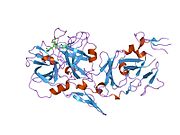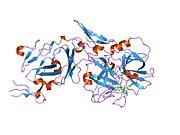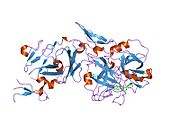Factor VII
Template:PBB Factor VII (formerly known as proconvertin) is one of the central proteins in the coagulation cascade. It is an enzyme (EC 3.4.21.21) of the serine protease class.
Physiology
The main role of factor VII (FVII) is to initiate the process of coagulation in conjunction with tissue factor (TF). Tissue factor is found on the outside of blood vessels - normally not exposed to the bloodstream. Upon vessel injury, tissue factor is exposed to the blood and circulating factor VII. Once bound to TF, FVII is activated to FVIIa by different proteases, among which are thrombin (factor IIa), factor Xa, IXa, XIIa, and the FVIIa-TF complex itself. The most important substrates for FVIIa-TF are Factor X and Factor IX.
The action of the factor is impeded by tissue factor pathway inhibitor (TFPI), which is released almost immediately after initiation of coagulation. Factor VII is vitamin K dependent; it is produced in the liver. Use of warfarin or similar anticoagulants impairs its function.
Genetics
The gene for factor VII is located on chromosome 13 (13q34).
Role in disease
Deficiency is rare (congenital proconvertin deficiency) and inherits recessively. Factor VII deficiency presents as a hemophilia-like bleeding disorder. It is treated with recombinant factor VIIa (NovoSeven).
Therapeutic use
Recombinant human factor VIIa (NovoSeven, eptacog alfa [activated], ATC code B02BD08) has been introduced for use in uncontrollable bleeding in hemophilia patients (with Factor VIII or IX deficiency) who have developed inhibitors against replacement coagulation factor.
It is being increasingly used in uncontrollable hemorrhage.[1] The first report of its use was in an Israeli soldier with uncontrollable bleeding in 1999.[2] The rationale for its use in hemorrhage is, that it will only induce coagulation in those sites where tissue factor (TF) is also present. Still, O'Connell et al. report an increased risk of deep vein thrombosis, pulmonary embolism and myocardial infarction in association with the use of rhFVIIa.[3]
According to a 2005 study, recombinant human factor VII improves outcomes in acute intracerebral hemorrhage.[4]
Interactions
Factor VII has been shown to interact with Tissue factor.[5][6]
References
- ^ Roberts H, Monroe D, White G (2004). "The use of recombinant factor VIIa in the treatment of bleeding disorders". Blood. 104 (13): 3858–64. doi:10.1182/blood-2004-06-2223. PMID 15328151.
{{cite journal}}: CS1 maint: multiple names: authors list (link) - ^ Kenet G, Walden R, Eldad A, Martinowitz U (1999). "Treatment of traumatic bleeding with recombinant factor VIIa". Lancet. 354 (9193): 1879. doi:10.1016/S0140-6736(99)05155-7. PMID 10584732.
{{cite journal}}: CS1 maint: multiple names: authors list (link) - ^ O'Connell K, Wood J, Wise R, Lozier J, Braun M (2006). "Thromboembolic adverse events after use of recombinant human coagulation factor VIIa". JAMA. 295 (3): 293–8. doi:10.1001/jama.295.3.293. PMID 16418464.
{{cite journal}}: CS1 maint: multiple names: authors list (link) - ^ Mayer S, Brun N, Begtrup K, Broderick J, Davis S, Diringer M, Skolnick B, Steiner T (2005). "Recombinant activated factor VII for acute intracerebral hemorrhage". N. Engl. J. Med. 352 (8): 777–85. doi:10.1056/NEJMoa042991. PMID 15728810.
{{cite journal}}: CS1 maint: multiple names: authors list (link) - ^ Carlsson, Karin (2003). "Probing the interface between factor Xa and tissue factor in the quaternary complex tissue factor-factor VIIa-factor Xa-tissue factor pathway inhibitor". Eur. J. Biochem. 270 (12). Germany: 2576–82. ISSN 0014-2956. PMID 12787023.
{{cite journal}}: Check date values in:|year=(help); Cite has empty unknown parameters:|laydate=,|laysource=, and|laysummary=(help); Unknown parameter|coauthors=ignored (|author=suggested) (help); Unknown parameter|month=ignored (help); Unknown parameter|quotes=ignored (help) - ^ Zhang, E (1999). "Structure of extracellular tissue factor complexed with factor VIIa inhibited with a BPTI mutant". J. Mol. Biol. 285 (5). ENGLAND: 2089–104. doi:10.1006/jmbi.1998.2452. ISSN 0022-2836. PMID 9925787.
{{cite journal}}: Check date values in:|year=(help); Cite has empty unknown parameters:|laydate=,|laysource=, and|laysummary=(help); Unknown parameter|coauthors=ignored (|author=suggested) (help); Unknown parameter|month=ignored (help); Unknown parameter|quotes=ignored (help)

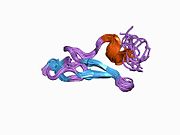
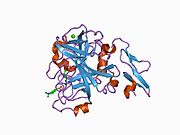


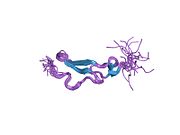

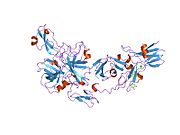

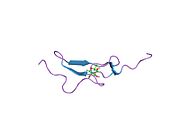
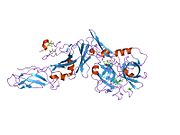
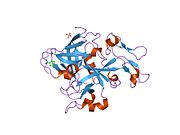







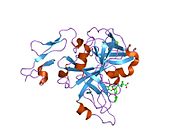
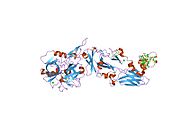

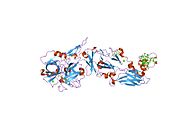


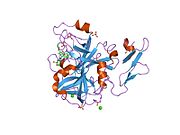
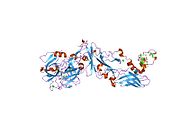

![2aei: Crystal structure of a ternary complex of factor VIIa/tissue factor and 2-[[6-[3-(aminoiminomethyl)phenoxy]-3,5-difluro-4-[(1-methyl-3-phenylpropyl)amino]-2-pyridinyl]oxy]-benzoic acid](http://upload.wikimedia.org/wikipedia/commons/thumb/d/d2/PDB_2aei_EBI.jpg/180px-PDB_2aei_EBI.jpg)

